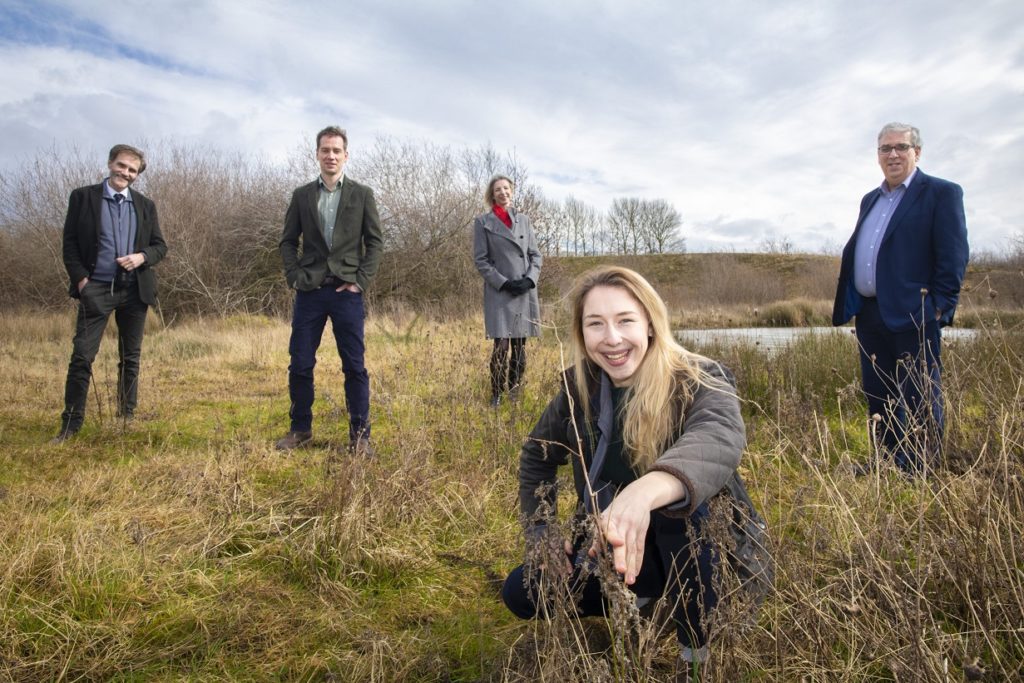
A former factory site has been transformed into an award-winning haven for wildlife by the arrival of Wales’s most modern police station.
North Wales Police’s new Eastern Command and Custody Facility on Llay Industrial Estate has picked up a major environmental accolade for the sensitive way it has been developed.
Where the huge Sharp electronics factory used to stand close to the Llay Main colliery, rare butterflies, birds and dragonflies hover and plants and flowers bloom among rush-lined pools.
It has led to a Special Commendation for the site at the Chartered Institute of Ecology and Environmental Management Awards for the development’s approach to ecology and the environment at the Eastern Divisional HQ and custody facility in Llay.
The recognition has been welcomed by North Wales Police and Crime Commissioner Arfon Jones who was responsible for the replacement of the old Wrexham Police Headquarters by the new £18 million facility and the creation of a new town centre police station in Wrexham.
Mr Jones, a former Police Inspector, said: “I’m a firm believer in the need to adopt new, greener building techniques to help combat climate change and also to provide a modern, eco-friendly and pleasant working environment for our staff.
“I was advised that it was better not to truck in hundreds of tons of topsoil to improve diversity and took that decision with the result that we now have a much richer and more diverse range of flowers, plants and creatures on the site.
“So, I’m delighted that the new Divisional Headquarters has been recognised and at the way the site has developed since it has been occupied.
“We have worked closely with Anna Pretious, the Force’s Environmental and Energy Conservation Manager, the developers, and with our environmental experts, Eco-scope, to make the ecology of the site a key priority – even the police cars are washed using recycled water.”
The green theme runs from outside to in with drainage pools and landscaping creating a perfect environment for a range of flora and fauna with solar panels and rainwater harvesting on the roof, sunlight shafts providing natural light to the cells and LED lighting throughout.
Most of the furniture is recycled from a bank in London, from Shire Hall in Mold and from the former HQ in Wrexham, much of it refurbished on site by South-Wales-based Orangebox, while external seating and tables are from Meifod Furniture in Denbigh.
Wildlife and plants include a little-known butterfly, the dingy skipper, wild orchids and a single example of the dwarf helleborine plant, spotted and saved by the Management Plan Ecologist Dr Richard Birch literally beneath the bucket of a JCB digger.
Dr Birch, now with Eco-Scope who has been involved with the site since 2013, long before work began on the new Divisional HQ, said: “I spoke to the Commissioner and advised it would be better and cheaper not to use topsoil and I was delighted when he promptly agreed.
“I couldn’t believe my ears when I heard that because this is all former industrial land with an old spoil tip from the colliery and it’s a fantastic place for wildlife.
“If you dump tons of topsoil here then you will just get grass outcompeting everything else but here you have such a rich diversity of flora and fauna and the single best thing you can do is have lots of ups and downs to make different habitats.
“It should be a Site of Special Scientific Interest just for the dragonflies. There are 11 species of them here, six different orchids and it’s also one of only three places in North Wales where you will find the rare pennyroyal plant.”
A Bio-Blitz held in 2019 identified 240 different species on the site and as well as the dragonflies these include 18 butterflies, 21 moths, assorted bees, wasps and soldier flies and 150 flowering plants.
The 8,680 square metre building, built by leading contractors Galliford Try, has offices and facilities for 248 police officers and staff including 32 cells, canteen facilities, and two gyms as well as locker rooms and garages.
It has an 80 kilowatt solar array on the roof, rainwater harvesting for washing 85 police vehicles a week, and smart lighting to conserve energy and already the building is showing that its energy use is 50 per cent lower than equivalent older buildings.
Anna Pretious said: “As a force we have been taking wildlife and bio-diversity very seriously for 20 years and here we had habitat and geological surveys done by Dr Birch which showed there was a mosaic of habitats here which have been protected during and after construction.
“For many years now the preservation of wildlife has been part and parcel of our thinking.”